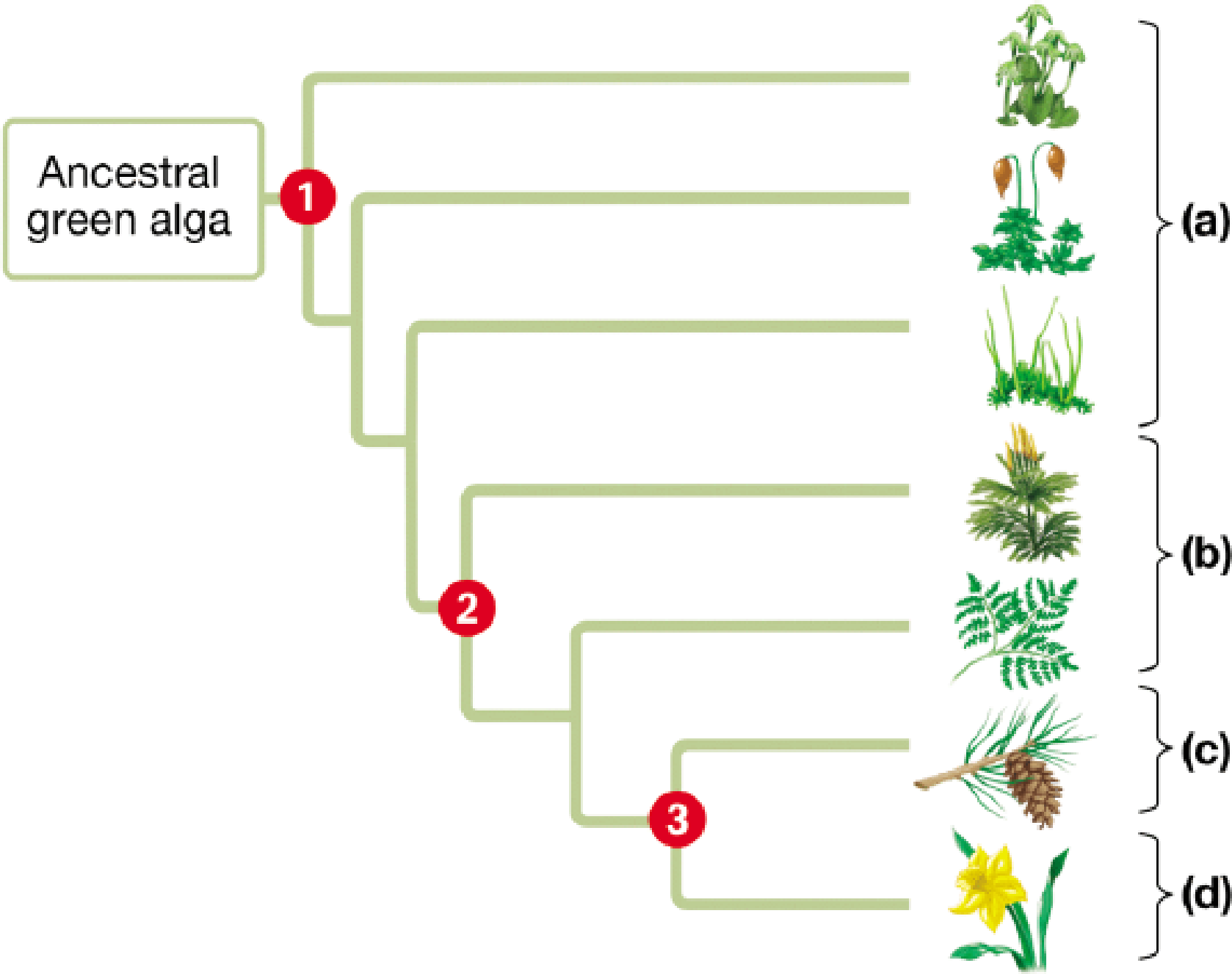
Concept explainers
In this abbreviated diagram, identify the four major plant groups and the key terrestrial adaptation associated with each of the three major branch points.

To determine: The four major plant group and their key terrestrial adaptation associated with each of the three major branch points.
Introduction:
The evolution of plants started with the origin of land plants that included the bryophytes. Land plants developed apical meristem and the embryos. After the land plants, the origin of vascular plants occurred. They involved the seedless fern and mosses. Lastly, the origin of seeded plants occurred. This includes the angiosperms and the gymnosperms.
Answer to Problem 1CC
Pictorial representation: The highlights of plant evolution are depicted in Fig.1.

Fig.1: The major events in plant evolution.
Explanation of Solution
The three distinct adaptations which gave rise to the four major plant groups are:
(1)
Correct answer: The origin of land plants.
Explanation:
The first terrestrial adaptation includes the origin of land plants. Their development included presence of the meristem and the embryos within the parent.
They include the major plant group (a) the bryophytes. The bryophytes are the non vascular plants and they evolved from the green algae about 475 million years ago. It included the development of apical meristem and embryos. For example: Mosses, hornworts, and liverworts. Hence, the correct answer is origin of land plants.
(2)
Correct answer: The origin of vascular plants.
Explanation:
The second adaptation includes the origin of vascular plants. It included the development of vascular tissues that helped the plants to grow tall and move away from the moist environment. They were now able to transport water to the leaves from the roots.
They include plant group (b) the seedless vascular plants. They evolved about 425 million years ago and include the ferns, club mosses and the horsetails. Hence, the correct answer is origin of vascular plants.
(3)
Correct answer: The origin of seed plants.
Explanation:
The third adaptation includes the origin of seed plants. They included the vascular seed plants. The seeds provided protection and dispersion of the embryos.
They include two major groups of plants:
Group (c) Gymnosperms: They include the seeded plants which have their seeds within the cones. They evolved about 360 million years ago. For example: pines, fir and spruce.
Group (d) Angiosperms: They include the vascular seeded plants that bear flowers. They evolved about 360 million years ago along with the gymnosperms. For example: rose, maple trees and oak trees. Hence, the correct answer is origin of seed plants.
Want to see more full solutions like this?
Chapter 17 Solutions
CAMPBEL BIOLOGY:CONCEPTS & CONNECTIONS
- Plant Diversity Know the phylum, domain and supergroup of land plants and its sister taxon. Describe at least four out of the seven derived traits of land plants. Describe and draw a general land plant life cycle (know the terms haploid, diploid, gametophyte, sporophyte, spore, meiosis, mitosis)arrow_forwardDiscuss the adaptations that have enabled flowering plants to overcome the following problems associated with life on land.* The absence of an aquatic environment for reproduction.* The absence of an aquatic environment to support the plant body.* Dehydration of the plant.arrow_forwardDescribe a modified structure and function of the following plant organs: Leaf - Stem - Root -arrow_forward
- Describe each of the following types of specialized shoots. Be certain to account for modifications of the leaves, internodes, and orientation of growth: stolon, rhizome, tuber, bulb, corm, and tendril. Each provides a plant with a selective advantage. What is the adaptive value of each type of specialized shoot?arrow_forwardGive all evidence that chara and green plants share a recent common ancestor (all shared derived characteristics).arrow_forwardLabel the internal parts of the following cross sections of monocot and eudicot plants:arrow_forward
- Differentiate the reproductive structures and processes of the four plant representatives according to the categories provided. Bryophye Pteridophyte Gymnosperm Angiosperm Female reproductive structure and distinguishing characteristic Male Reproductive structure and distinguishing characteristicarrow_forwardREAD THE FOLLOWING INSTRUCTIONS: Bryophytes in which the gametophytes are "leafy" in appearance and the sporophytes grow conspicuously from the tips of the gametophyte plants. STEP 1: Examine the mass of moss plants and then select one or two individual gametophyte plants and note the leaf-like (not true leaves because they lack conducting tissue) structures which are arranged around a central, vertical "stem-like" stalk and root-like rhizoids which anchor the plant and absorb water and nutrients. STEP: The sex organs are in the tips of the plants and must be seen with the microscope. Study a slide of a vertical section through head of a mate plant and note the many antheridia. STEP 3: Examine a slide through a vertical section of a female plant. Note the many upright archegonia each on a tall stalk and each with a swollen base or venter containing an egg and an elongate neck. Note the filamentous paraphyses between the archegonia. STEP 4: Examine a living or preserved…arrow_forwardThe rapid turgor movements of the sensitive plant (Mimosa pudica) are rare in the Plant Kingdom. If all plants evolved such movements, would the phenomenon have possible survival value or other value to the plants? Explain.arrow_forward
- Compare a fern species such as a local epiphytic fern with a Caulerpa species. State the plant division to which they each belong. Identify the habitat of each species. Identify three (3) structural (morphological) characteristics which they share and one (1) internal structural characteristic which they do not share.arrow_forwardExplain the process of secondary growth in the stems of woody angiospermswith the help of schematic diagrams. What is its significance?arrow_forwardPlease type a brief definition of the following terms Photoperiod - Long day vs. Short day vs. Day-neutral plants - Merosity - Quartet model - Orthologs - Microsporangium - Staminode - Self-incompatibility (SI) - Aggregate vs. multiple fruits - Homology vs. Homoplasy -arrow_forward
 Biology (MindTap Course List)BiologyISBN:9781337392938Author:Eldra Solomon, Charles Martin, Diana W. Martin, Linda R. BergPublisher:Cengage Learning
Biology (MindTap Course List)BiologyISBN:9781337392938Author:Eldra Solomon, Charles Martin, Diana W. Martin, Linda R. BergPublisher:Cengage Learning
